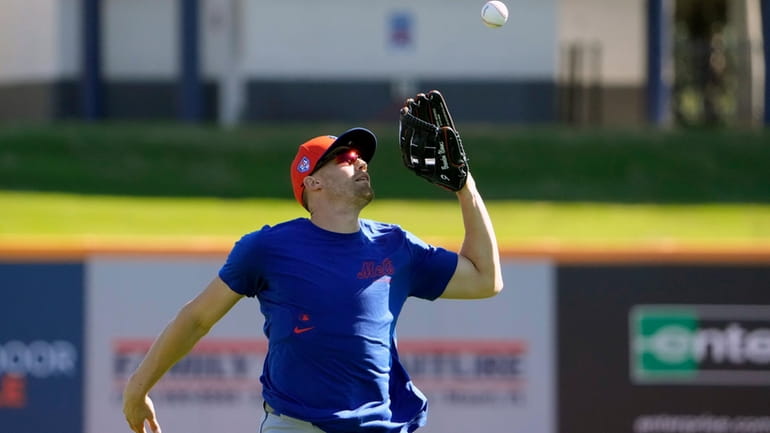Mets have excelled at keeping their players on the field over past two seasons

New York Mets' Brandon Nimmo (9) catches a ball during a spring training baseball workout Tuesday, Feb. 20, 2024, in Port St. Lucie, Fla. Credit: AP/Jeff Roberson
PORT ST. LUCIE, Fla.
Listening to Brandon Nimmo, a load-management success story, almost makes you believe the Mets’ long history of medical calamities eventually could be a thing of the past.
The operative word being “almost.” Accidents happen. Players inevitably get hurt, as Kodai Senga did with his shoulder strain last month. But in Nimmo’s case — and really, a decent chunk of the Mets’ core — the team’s protocols have proved fairly effective, at least on the position-player side.
Over the past two seasons, the Mets are the only team to have four players among the top 31 in total games played: Francisco Lindor (321) ranked third, Pete Alonso (314) was No. 14, Jeff McNeil (304) was No. 28 and Nimmo (303) was No. 31. The runner-up was the Rangers with three; the Guardians and Atlanta each had two.
Obviously, there is some luck involved (McNeil already is sidelined this spring with a sore biceps). Grinding through 162 games stretched over six months is a treacherous jungle to navigate. Bad hops, wild fastballs and ill-timed leaps into walls are all work-related hazards. But Nimmo — who delayed his first Grapefruit League start until Sunday, the Mets’ ninth game — is Exhibit A when it comes to playing smarter rather than red-lining past the breaking point.
Two years ago, with the start of spring training pushed back by the sport’s labor lockout, Nimmo devised a plan to scale back his March reps to preserve himself for the regular season. It didn’t hurt that he was heading into a contract year — an optimal time to pad the Scott Boras binder — but the “less is more” approach allowed him to stay on the field at an unprecedented rate.
“The results speak for themselves,” Nimmo said. “So if it’s not broke, don’t fix it.”
Before 2022, he reached the 100-game plateau only once in six seasons, when he logged 140 in 2018. But during the past two seasons, through collaboration with the Mets’ training staff, Nimmo has played 151 and 152, respectively.
The way Nimmo describes it, that’s not luck. Nor is it technically what’s often criticized as “load management,” a phrase that is universally ripped outside clubhouses and locker rooms.
Former Mets manager Buck Showalter piled on during the offseason when he took shots at the team’s handling of certain players on the “Foul Territory” podcast — Nimmo being the only one he singled out by name. Showalter mentioned a “guy that hit a triple and two doubles” and then was told he “probably needs a day off because he ran too much around the bases. So what do you want me to tell him, ‘Don’t get any hits so you can play the next day?’ . . . I said, OK, you go out there and tell Brandon Nimmo that he’s not playing today because he did too well last night.”
Nimmo smiled when I relayed that comment to him after Sunday’s 5-2 loss to the Astros at Clover Park. On Sept. 12 of last season, he did go 3-for-4 with two doubles and a triple, but he was right back in the starting lineup the following day, and the next 10 days after that.
As for Showalter’s remarks, Nimmo emphasized that it’s not quite that simple. The concept of load management for him is much more nuanced.
With everyone wired for data feedback these days, Nimmo’s workload as a speed-dependent outfielder is closely monitored. If he starts pushing the boundaries of physical exertion, he will consult with the training staff about other areas to cut down in order to keep him healthy — such as his conditioning drills, etc. By preserving himself in those other ways, Nimmo doesn’t necessarily need a night off. Judging by the past two years, the plan has proved to be effective.
“I think there’s a right way to do it,” Nimmo said. “I think you drive the ship and you listen to your body and you come up with a plan, but be adjustable on it. I don’t think it has to be like, ‘this is what the numbers say, so you need this.’ But ultimately it comes down to, how’s my body feel? And what decision are we going to make together with the information that we have and how I feel?”
With Nimmo’s switch to seeing more time in leftfield this season, that should decrease the physical stress and potentially bump up his number of starts. And easing into these Grapefruit League games was hugely beneficial the previous two seasons.
“Each time we go through it,” Nimmo said, “we know a little bit better what to do.”
The Mets’ two iron men, Lindor and Alonso, already have played in five spring training games. So as Nimmo alluded to, it’s not a one-size-fits-all approach.
Since 2019, Alonso has played in 684 games, which ranks third in the majors behind Marcus Semien (700) and Freddie Freeman (697). For him, staying on the field isn’t a strictly scientific endeavor. Alonso explained that there’s an “art” to it.
“Everyone goes through their hardships physically during the season,” Alonso said. “You have to put yourself in a position to play through certain things, work during the offseason to make sure your body is durable and strong throughout the year, and do your pregame prep work. It’s also personal willpower and the power of competition . . . There’s no formula where it’s a certain percentage of this or that. It’s always an ever-changing thing.”
Nimmo suggests those changes are trending in a positive direction.

